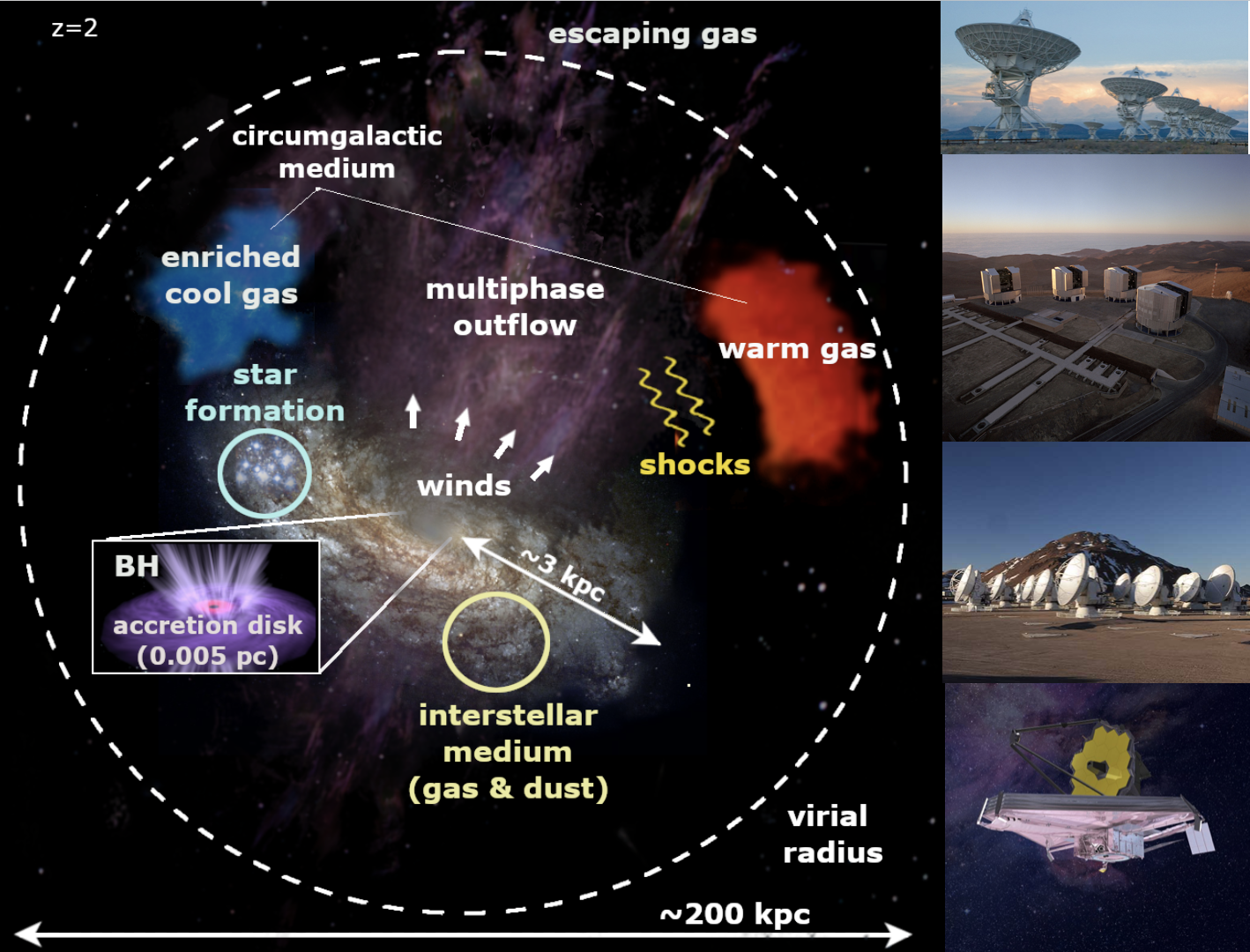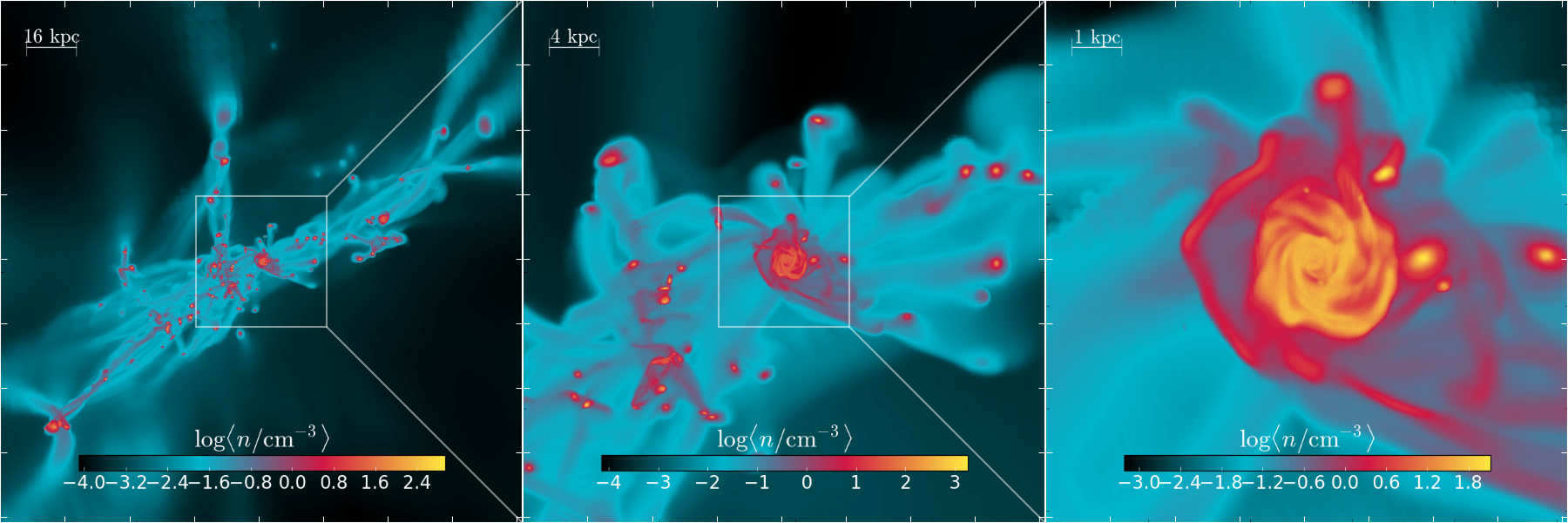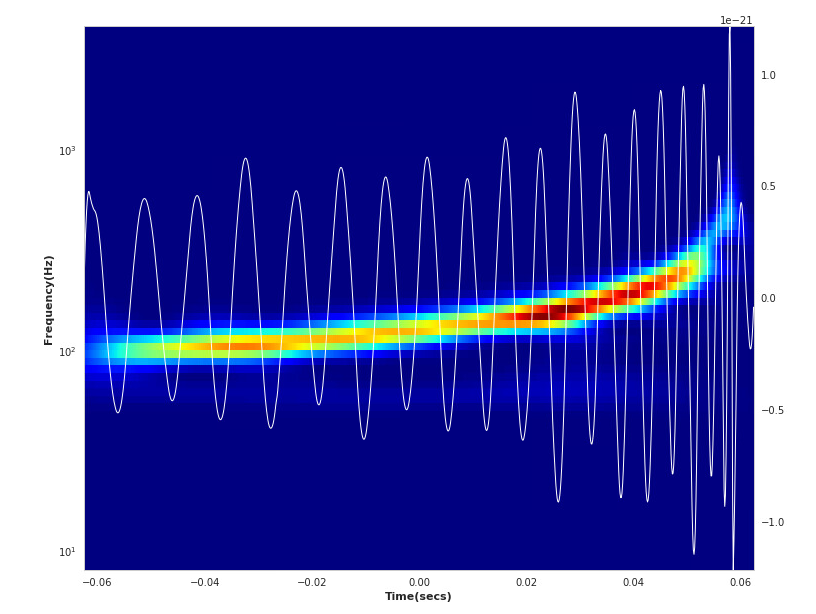Research activity
 Joint evolution of supermassive black holes and galaxies
Supermassive black holes (SMBH) reside at the center of galaxies and release an extraordinary amount of energy during their accretion phase. Such energy drives galaxy-scale gas outflows that can significantly influence the evolution of the host galaxy. Despite the remarkable theoretical and observational progress in quantifying the energetics and dynamics of such outflows, establishing their role during the formation and evolution of galaxies remains a long-standing problem in modern astrophysics. The Comsology group at SNS analyzes and interprets multi-wavelength spectroscopic data obtained with the new cutting-edge telescopes (VLA, ALMA, VLT, JWST) in order to identify outflows in high redshift (z>2) galaxies and characterize their properties. The research activity is also supported by the project WINGS (a 1.2 million euro Starting Grant award (2021-2026) financed by the European Research Commission*) that will help us to assemble the largest high-spatial resolution survey of SMBH-driven outflows and define their impact on the host galaxies.
Joint evolution of supermassive black holes and galaxies
Supermassive black holes (SMBH) reside at the center of galaxies and release an extraordinary amount of energy during their accretion phase. Such energy drives galaxy-scale gas outflows that can significantly influence the evolution of the host galaxy. Despite the remarkable theoretical and observational progress in quantifying the energetics and dynamics of such outflows, establishing their role during the formation and evolution of galaxies remains a long-standing problem in modern astrophysics. The Comsology group at SNS analyzes and interprets multi-wavelength spectroscopic data obtained with the new cutting-edge telescopes (VLA, ALMA, VLT, JWST) in order to identify outflows in high redshift (z>2) galaxies and characterize their properties. The research activity is also supported by the project WINGS (a 1.2 million euro Starting Grant award (2021-2026) financed by the European Research Commission*) that will help us to assemble the largest high-spatial resolution survey of SMBH-driven outflows and define their impact on the host galaxies.
 Cosmic reionization and 21 cm studies
Our goal is to investigate the birth of the very first stars and galaxies in our Universe, occurring over 13 billion years ago. These galaxies are too faint to be seen directly, even with the most advanced telescopes. Yet their light heated and ionized virtually every atom in the Universe, in an important milestone called Cosmic Reionization. We are developing state-of-the-art simulations and statistically comparing them to observations. In doing so, we will quantify what can we learn about the first galaxies from the timings and patterns of Cosmic Reionization. Ultimately, AIDA (An Illumination of the Dark Ages, a 1.5 million euro Starting Grant award (2015-2020) financed by the European Research Commission*) will help us understand the mysterious origins of the structures of our Universe.
Cosmic reionization and 21 cm studies
Our goal is to investigate the birth of the very first stars and galaxies in our Universe, occurring over 13 billion years ago. These galaxies are too faint to be seen directly, even with the most advanced telescopes. Yet their light heated and ionized virtually every atom in the Universe, in an important milestone called Cosmic Reionization. We are developing state-of-the-art simulations and statistically comparing them to observations. In doing so, we will quantify what can we learn about the first galaxies from the timings and patterns of Cosmic Reionization. Ultimately, AIDA (An Illumination of the Dark Ages, a 1.5 million euro Starting Grant award (2015-2020) financed by the European Research Commission*) will help us understand the mysterious origins of the structures of our Universe.
 Galaxies at the epoch of reionization
In the past years, we have witnessed spectacular progresses in the discovery and characterization of galaxies in the epoch of reionization, as optical/near infrared survey yielded crucial information on the star formation rates, stellar mass and sizes of these primeval objects. In spite of these successes, little is known about the physical properties of early galaxies, such gas/dust content, structure/dynamics of their interstellar medium, escape fraction of ionizing photons, cosmic rays, magnetic fields. The situation is changing rapidly with the advent of ALMA and the forthcoming JWST, providing spatially resolved, multi-wavelength spectroscopical information. At the SNS we develop theoretical models based on detailed hydrodynamical simulations, radiative transfer schemes and machine learning algorithms, in order to understand current observations, guide future survey that in in turn will better constrain theoretical models. INTERSTELLAR (a 2.2 million euro Advanced Grant award (2017-2022) financed by the European Research Commission*) will help to understand the internal structure and interstellar medium of galaxies in the Epoch of Reionization.
Galaxies at the epoch of reionization
In the past years, we have witnessed spectacular progresses in the discovery and characterization of galaxies in the epoch of reionization, as optical/near infrared survey yielded crucial information on the star formation rates, stellar mass and sizes of these primeval objects. In spite of these successes, little is known about the physical properties of early galaxies, such gas/dust content, structure/dynamics of their interstellar medium, escape fraction of ionizing photons, cosmic rays, magnetic fields. The situation is changing rapidly with the advent of ALMA and the forthcoming JWST, providing spatially resolved, multi-wavelength spectroscopical information. At the SNS we develop theoretical models based on detailed hydrodynamical simulations, radiative transfer schemes and machine learning algorithms, in order to understand current observations, guide future survey that in in turn will better constrain theoretical models. INTERSTELLAR (a 2.2 million euro Advanced Grant award (2017-2022) financed by the European Research Commission*) will help to understand the internal structure and interstellar medium of galaxies in the Epoch of Reionization.
 Observations and simulations of z~6 quasars
Black holes of the order of millions to billions solar masses (Super Massive Black Holes, SMBH) are present in the cores of local galaxies as well as in the most distant Universe, shining as luminous quasars. Since the beginning of the new millennium, more than 100 of these luminous quasars have been discovered at z~6 through several surveys, and followed-up with multi-wavelength observations. These data represent golden mines for studying the properties of the high redshift Universe both on cosmological (≥ tens of Mpc) and galactic scales (≤ tens of kpc).
Observations and simulations of z~6 quasars
Black holes of the order of millions to billions solar masses (Super Massive Black Holes, SMBH) are present in the cores of local galaxies as well as in the most distant Universe, shining as luminous quasars. Since the beginning of the new millennium, more than 100 of these luminous quasars have been discovered at z~6 through several surveys, and followed-up with multi-wavelength observations. These data represent golden mines for studying the properties of the high redshift Universe both on cosmological (≥ tens of Mpc) and galactic scales (≤ tens of kpc).
On large scales, observations of z~6 quasars have been extensively used as powerful probes of the cosmic reionization and metal enrichment processes. The Cosmology group at SNS analyse and model optical/near-infrared absorption spectra of z~6 quasars in the spectral region blue-ward the Lyα emission line, with special regard to quasar near zones, deep absorption gaps, and metal absorption lines. The final aim is to measure the intergalactic medium neutral hydrogen fraction and the abundance of metals in the IGM, thus constraining models of the cosmic reionization and metal enrichment processes.
On small scales, z~6 quasars are ideal laboratories for studying the properties of the host galaxy and its coeval formation with the SMBH they contain. The Cosmology group at SNS compare sub-millimeter (e.g. VLA, ALMA and NOEMA) and X-ray (Chandra) observations (e.g VLA, ALMA and NOEMA) of z~6 quasars with outcomes of cosmological simulations. These kind of studies allow to characterise the properties of z~6 quasar host galaxies (star formation rate, dust masses, molecular hydrogen mass, feedback) and may suggest new tools for detecting the progenitors of SMBHs, with important implications for the formation of these massive systems and the contribution of faint quasars to cosmic reionization.
 Machine Learning for Gravitational Wave astronomy
Data pre-processing is fundamental to detect a Gravitational Wave(GW) signal, as the historical first detections proved. Any detection pipeline should benefit from well understood data as much as possible. At the same time, with the incoming Observation runs of the present generation detectors and with the 3rd generation ones, the number of detectable GW events will increase and we need to be fast enough in characterizing the detector data and identifying the transient signals. We work on developing data analysis methods for the robust identification, classification and modelling of transient signals (glitches) in GW data. The Artificial Intelligence represents a valuable technique to reach these goals. The group is working on developing cutting-edge machine and deep learning techniques for the analysis of GW data in a wide international collaboration. This work is inserted also in the EU program,
Cost Action 17137 : A network for Gravitational Waves, Geophysics and Machine Learning, in ESCAPE project and in the informal Machine Learning group in LIGO/Virgo collaboration.
Machine Learning for Gravitational Wave astronomy
Data pre-processing is fundamental to detect a Gravitational Wave(GW) signal, as the historical first detections proved. Any detection pipeline should benefit from well understood data as much as possible. At the same time, with the incoming Observation runs of the present generation detectors and with the 3rd generation ones, the number of detectable GW events will increase and we need to be fast enough in characterizing the detector data and identifying the transient signals. We work on developing data analysis methods for the robust identification, classification and modelling of transient signals (glitches) in GW data. The Artificial Intelligence represents a valuable technique to reach these goals. The group is working on developing cutting-edge machine and deep learning techniques for the analysis of GW data in a wide international collaboration. This work is inserted also in the EU program,
Cost Action 17137 : A network for Gravitational Waves, Geophysics and Machine Learning, in ESCAPE project and in the informal Machine Learning group in LIGO/Virgo collaboration.
Our research is generously supported by the following institutions/agencies:
*Any dissemination of results must indicate that it reflects only the author’s view and that the Commission is not responsible for any use that may be made of the information it contains.






